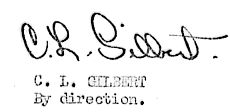

| DEPARTMENT OF THE NAVY OFFICE OF THE CHIEF OF NAVAL OPERATIONS WASHINGTON 25, D. C. |
||
| IN REPLY REFER TO Op-3222F2/im, Ser 00992P32 |
||
| 23 JULY 1952 |
SECURITY INFORMATION
| From: | Director of Naval Intelligence |
| To: | Commanding General, Air Material Command Attention: ATIC |
| Subj: | Unusual Radar Scope Presentation, report of |
| Ref: | (a) DNI Conf. ltr Ser 016236P32 dtd 19 Oct 1950 and enclosure thereto (AFOIN Memo to CNO(DNI) of 18 Sept 1950) |
| Encl: | (1) HGQ MACG-2 secret ltr ser 00146 of 22 Feb 1952 |
1. Enclosure (1) is forwarded for information in accordance with reference (a).
2. If any conclusions are drawn from this report they would be of interest to this office.

FF14/MACG-2
E-3/ZCD/bol
J15-7
Ser: 00145
22 FEB 1952
From: Commanding Officer, Marine Air Control Group 2 |
|
|
To: Commanding General, Far East Air Forces (Attn: C/I Reconnaissance) |
|
Via: (1) Commanding General, First Marine Air Wing |
|
|
Subj: Unusual Radar Scope Presentation, report of |
|
|
(a) AR 350.07 (24 Aug 51) Int-Fac and 1st End by CG, 5th AF, |
|
|
(b) MACG-2 Secret Dispatch 170725Z |
|
|
Encl: (1) Sketch of Tracks |
1. In accordance with reference (a), the following report of unusual Radar Scope Presentations is submitted.
2. Observations of the two incidents reported herein were made by Marine Ground Control Intercept Squadron 3, located on the Yongil Peninsula, ten miles northeast of X-3. Each track was plotted on the plan Twelve Indicator of the AN/CPS-5 radar which was functioning normally. Altitude data was not obtained, and no attempt was made to determine the minimum and maximum angle of antenna tilt through which the contact could be observed. Sketches of the two tracks are submitted as enclosure (1).
3. The initial plot of track number one was observed at 1440, 16 February 1952.
a. As shown on enclosure (1), the track followed a course of 186 degrees, faded at P? 0579, [37°00'N-130°19''E)], reappeared at ?P7580 [34°56'N-129°-54'E] for two additional plots and disappeared at ?P 686C. [34°37''N-129°50''E.] Since the antenna was rotating at a speed of 4 revolutions per minute, the time lapse between successive plots was 15 seconds. From this data, the calculated average speed of the target was 4320 nautical miles per hour.
b. The appearance of the target response was similar to that received from a single jet type aircraft.
|
FFIA/MACG-2 S-3/ECO/gaw J15-7 Ser: 00146 22 Feb 1952 |
SECURITY INFORMATION
c. Operational characteristics of the AN/CP5-5 Radar, at the time of the incident, were as follows:
(1) Frequency - 1298 megacycles.
(2) Pulse Repetition Frequency - 600 cycles.
(3) Pulse width - 2 microseconds.
(4) Range Scale Employed - 140 miles.
(5) MTI inoperative. Ground return was ten to thirty miles
irregular.
d. The object was not sighted visually. There were high scattered clouds, with visibility to ten miles. Seas were running high.
4. The initial plot of the track number two was observed at 1550, 16 February 1952.
a. As shown on enclosure (1), the track followed a course of 170 degrees, faded momentarily at ER 3320 and proceded on a course of 120 degrees until contact was lost at ER 6200. The antenna was rotating at a speed of four revolutions per minute and the calculated average speed of the target was 1380 nautical miles per hour.
b. The appearance of the target response was similar to that normally received from a flight of 6 or 8 jet type aircraft.
c. Operational characteristics of the AN/CPS-5 Radar were as listed in paragraph 3 c above.
d. Visibility was 10 to 12 miles, with high scattered clouds. A single contrail was observed in the general area in which the target was tracked.
M. A. SEVERSON
|
|
|
|
|